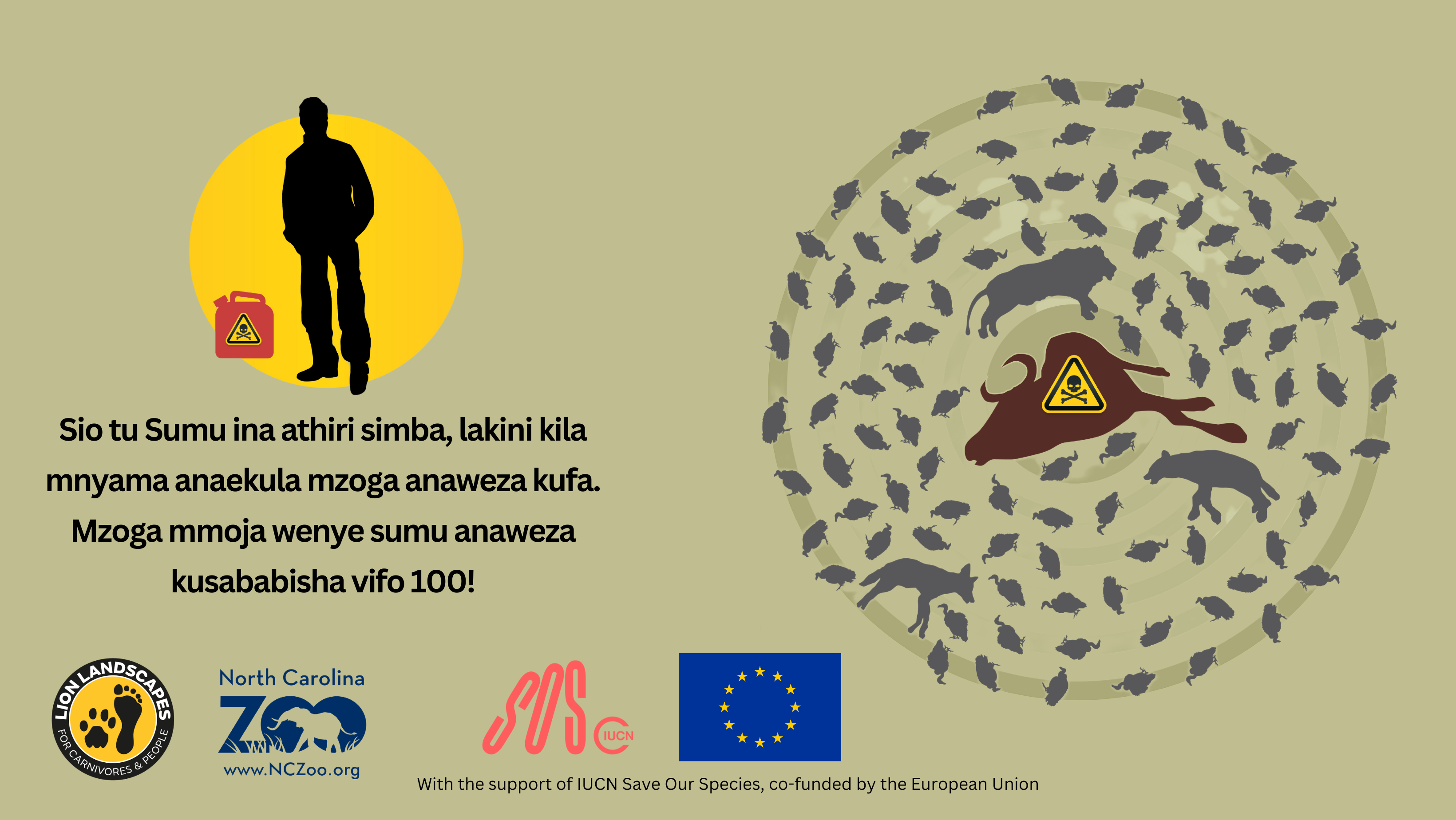Changing behaviour to stop the loss of wildlife through poisoning
- Lion Landscapes

- Jan 17, 2023
- 4 min read
Updated: Apr 23, 2024
Livestock predation is the leading cause of retaliatory killings of lions and other large carnivores often through poisoning. The poison is just common pesticides which are easily accessible and affordable. The cascading effects from one poisoning event are tremendous as it not only kills these large carnivores, but any animal that eats the carcass - including hyaena, jackals, eagles and critically endangered vultures. Secondary poisoning leads to the death of animals that feed on other animals that have been poisoned. One poisoned carcass can cause hundreds of deaths and therefore has a devastating effect on the ecosystem. There is also conceivable risk that pesticide contamination in the environment causes illness or death of livestock, and can impact human health.
Left: Graphic used in training communities about effects of poisoning. Right: example of a poisoning that killed not only lions but also many critically endangered vultures.
While these retaliatory poisonings are devastating for wildlife, it is important to begin by understanding the extent of predator conflict that communities have to endure. In some cases, pastoralists can lose a significant number of livestock in one night, driving the owners to resort to poisoning. The economic loss to the affected households can be desolating and unbearable. In the words of our joint CEO Dr Dickman, "They do what any one of us would if our livelihoods and children were threatened. The reality is that they (wildlife) are extremely difficult to live alongside.”
Our partners The Peregrine Fund (TPF) have found that most people do not understand the wider impacts of poisoning or do not make the connection between pesticide/herbicide contamination and the illness or death of their livestock or the impact on their own health. Quite a number of health problems in livestock result from exposure to excessive quantities of herbicides. To better understand this and reduce the incidences of poisoning in response to livestock loss we educate communities about the human and livestock health risks of using poison.
Based on the successful Community Coexistence Training, which was developed by TPF and continues to be implemented in Laikipia, Kenya in partnership with Lion Landscapes, we again worked with TPF and North Carolina Zoo (NCZ), to develop a site-specific coexistence training programme for Southern Tanzania. The training has two main components: preventing human-carnivore conflict and impacts of poisoning. The first part empowers people on how to better protect their livestock from predation, e.g. enabling villagers to construct or improve their own predator-proof enclosures, improving daytime herding practices and improving livestock management. The second part of the training raises awareness about the hazards - for people, livestock, wildlife and the wider environment - associated with using poisons, the signs and symptoms of poisoning, and training on personal safety when handling pesticides.
In April 2022, members of TPF and NCZ visited our work site in Selous-Nyerere landscape, Tanzania to gain a better understanding of the types of human wildlife conflict occurring in this landscape by interviewing both our staff and stakeholders from the local communities. The training was adapted to local circumstances and our field team, including the Lion Extension Officers (LEOs), were trained. By taking a ‘train the trainers’ approach, our team of trainees have then been able to go out and share their expertise and skills with the wider community.
Left: Martin Odino from TPF (on the right) training the field team and LEOs on the effects of poison, and how to decontaminate a poisoning site. Right: LEOs undergo continuous refresher training.
In June 2022, the poisoning training started to be implemented in the Selous-Nyerere landscape and by the end of the year 423 people had been trained. The results have been encouraging as more people report understanding that using poison is not only illegal, but dangerous for them and their communities. Among the trainees there was a 39% increase in the number of people that know that using poison to kill wildlife is illegal and a 30% increase in the number of people who said they would persuade someone else not to use poison if they had it. We also recorded a 28% increase in the number of people who thought it would be positive to have a community agreement to penalise people who use poison.

Community Coexistence Training in Mloka village, Selous-Nyerere
At the same time as this training rolled out in Selous-Nyerere, training was ongoing in Laikipia, Kenya - implemented directly by TPF as part of the Coexistence Co-op, reaching 167 people during the same time period. In Laikipia, there was a 53% increase in the number of people who understand poison used for wildlife can also kill people and 16% more people reported that they would try to convince someone who has poison not to use it. There was an increase of 44% in the number of people who reported they know how to build a wire boma and 20% more people reported they intended to build a wire boma in their household.

The training not only focuses on stopping the loss of lions to retaliatory poisoning, it also helps the communities to reduce the cost of living alongside wildlife through good livestock husbandry practices (photos: M. Odino).
To support the shift in attitude to view wildlife more positively, we also started doing educational trips into Nyerere National Park, reaching a total of 165 community members. Of the people who were brought to visit the park, 85% reported having a more positive view of the National Park after their visit.

Educational park trip to Nyerere National Park - the first opportunity for these community members to watch lions in a non-threatening environment.
Another educational channel that we are using with schools in the areas we work with is the distribution of our storybooks. In Haikya the Hyaena Friend a poisoning incident is specifically addressed.
We are grateful to IUCN Save Our Species and the European Union, together with the co-funders Lion Recovery Fund, The Nature Conservancy and others, for the support of this work that is so valuable for positive conservation.
With the support of IUCN Save Our Species, co-funded by the European Union
This publication was produced with the financial support of the European Union through IUCN Save Our Species. Its contents are the sole responsibility of Lion Landscapes and do not necessarily reflect the views of IUCN or the European Union.
Stay in touch
You can visit our website and keep up to date on our work and research in Africa by subscribing to our general newsletter. Join us on Facebook, Instagram, Twitter and LinkedIn for recent photos and stories from the field.
.png)














Comments